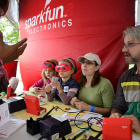Solarbotics Ltd.
Member Since: September 4, 2008
Country: Canada
-
Nice Chassis. The ABS is nice and tough, but how are you laser cutting it and getting rid of the smell?
-
These are really nice little strings, and brought them in to distribute in Canada at Solarbotics. Part of what we do is play with most of the things we bring in, so while we played with these, we tested them at several voltages (3, 4.5, 6, 7.6V), measuring the current consumption and the lux output of the last LED in the string.
Feel free to check out the results pdf.
-
Mount a strip of 90degree SMD edge-lit LEDs on one side, a flat coil behind them, and a hard-mount point behind the coil. Suspend over a magnet. Feed coil AC waveform, sync the LEDs to the waveform and create a micro-miniature POV, with a very narrow, but detailed (and super high framerate). Think like a miniature 8x1 dot matrix display that starts as an edge-viewed slice of film until it powers up, and starts oscillating up and down. Also doubles as a miniature fan, pulling air past the coil and LEDs.
I used to do lots of experiments with old BEAM bicore circuits, floppy drive coils, and neodymium magnets, so I know this is physically possible. Made some pretty slick looking flapping devices this way, but the traces in the Kapton wore out.
-
Not available for back-order? Does this mean they're EOL (end of life)?
-
Interesting device. I remember my parents having an "add-on" tv remote control that used ultrasonics, which is where the 48kHz standard came from - manufactures moved to the cheaper IR emitter/detectors, but only had to do a minor tweak to the ultrasonic circuits to make it work.
Just wondering why 48kHz wasn't used in this project? Probably outside the audio generation ability of smartphone speakers?
-
For those interested, there's an interesting set of thought experiments on simple robot behaviors in the book "Vehicles" by Valentino Braitenberg (wikipedia: http://en.wikipedia.org/wiki/Braitenberg_vehicle).
Gets a bit deep after the first few chapters, but we've similar ideas building BEAM style robots for a long time using this sort of design philosophy.
-
We've been coming down to San Mateo Maker Faire since the first one, and had a presence at all but the first.
We too were surprised by the spike in booth fees, and coming all the way down from Canada, we simply couldn't absorb the rate increase to host another free-Arduino workshop like we did last year. We'll be still coming down (just 2 of us) to help out at the Maker Shed, but no booth. We'll be putting some of those resources to doing alternate shows, like the Calgary Entertainment Expo (last weekend - FUN!), and the mini-maker Faires in Vancouver & Calgary.
Save a turkey leg for us - we'll bring the frozen lemonades! -Dave (President of Solarbotics Ltd)
-
What sort of rotational friction does this offer to the system? Does is spin freely if giving a snap of the fingers, or is there a definite drag so it stops almost immediately after removing the rotational force?
-
Suggestion: Why not use the regular G/V/S layout for pinout? Gnd / Vcc / Signal? Then it'd match practically any servo connector wire pinout.
-
Solarbotics.com - we're in Calgary Alberta, and are pretty much the same price. ~$10 shipping...
No public wish lists :(







